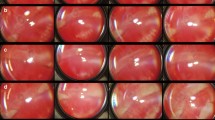Summary
Possible toxic effects of chlorhexidine (CHX) on the sympathetic adrenergic ground plexus were studied in whole mounts of albino rat irides using Falck-Hillarp fluorescence histochemistry. CHX dissolved in an isotone, buffered sodium-acetate solution or in 70% alcohol was injected into the anterior chamber of eye. CHX caused a marked and dose-dependent degeneration of adrenergic nerves. Two days after the lowest dose, 0,25 μg (5 μl of a 0.05% CHX solution), approximately 30% of the nerves had disappeared. Almost complete degeneration was observed after the same time with higher doses (2.5 μg, 5.0 μg, and 7.5 μg corresponding to 0.5, 1.0, and 1.5% CHX respectively). Two weeks after the lowest dose, the nerves had regenerated almost completely. With the highest dose used, only some 40% of the normal adrenergic nerve plexus had reformed after 51 days. Alcohol as a solvent did not have an additive effect on the neurotoxic action caused by CHX. The results demonstrate yet another aspect of chlorhexidine neurotoxicity, degeneration of peripheral adrenergic nerve terminals. This suggests that neurotoxic actions on thin unmyelinated fiber systems should be looked for also in the central nervous system (CNS).
Similar content being viewed by others
References
Ansel HC (1967) Hemolysis of erythrocytes by antibacterial preservatives. IV. J Pharm Sci 56:616–619
Aursnes J (1981a) Vestibular damage from chlorhexidine in guinea pigs. Acta Otolaryngol 92:89–100
Aursnes J (1981b) Cochlear damage form chlorhexidine in guinea pigs. Acta Otolaryngol 92:259–271
Bicknell PG (1971) Sensorineural deafness following myringoplasty operations. J Laryngol Otol 85:957–961
Björklund H, Hoffer B, Olson L, Seiger Å (1981) Differential morphological changes in sympathetic nerve fibers elicited by lead, cadmium, and mercury. Environ Res 26:69–80
Case DE (1977) Satety of Hibitane. I. Laboratory experiments. J Clin Periodontol 4:66–72
Corrodi H, Jonsson G (1967) The formaldehyde fluorescence method for the histochemical demonstration of biogenic monoamines. A review on the methodology. J Histochem Cytochem 15:65–78
Falck B (1962) Observations on the possibilities of cellular localization of monoamines by a fluorescence method. Acta Physiol Scand [Suppl 197] 56:1–25
Falck B, Hillarp N-Å, Thieme G, Torp (1962) Fluorescence of catecholamines and related compounds condensed with formaldehyde. J Histochem Cytochem 10:384–354
Foulkes DM (1973) Some toxicological observation on chlorhexidine. J Periodontol Res [Suppl 12] 8:55–57
Henschen A, Olson L (1983) Hexachlorophene-induced degeneration of adrenergic nerves: Application of quantitative image analysis to Falck-Hillarp fluorescence histochemistry. Acta Neuropathol (Berl) 59:109–114
Hugo WB, Longworth AR (1964) Some aspects of the mode of action of chlorhexidine. J Pharm Pharmacol 16:655–652
Jonsson G (1980) Chemical neurotoxines as denervation tools in neurobiology. Ann Rev Neurosci 3:169–187
Malmfors T (1965) Studies of adrenergic nerves. The use of rat and mouse iris for direct observations on their physiology and pharmacology at cellular and subcellular levels. Acta Physiol Scand [Suppl 284] 64:1–93
Morgan JF (1979) Complications associated with contact lens solutions. Ophthalmology (Rochester) 86:1107–1119
Olson L, Hamberger B, Jonsson G, Malmfors T (1968) Combined fluorescence histochemistry and3H-noradrenaline measurements of adrenergic nerves. Histochemie 15:38–45
Olson L, Malmfors T (1970) Growth characteristics of adrenergic nerves in the adult rat. Fluorescence histochemical uptake studies using tissue transplant to anterior chamber of the eye. Acta Physiol Scand [Suppl 348]:1–112
Osmundsen PE (1982) Contact dermatitis to chlorhexidine. Contact Dermatitis 8:81–83
Rushton A (1977) Safety of Hibitane. II. Human experience. J Clin Periodontol 4:73–79
Schaupp H, Wohnaut H (1978) Geschmackstörungen durch Munddesinfizientien. HNO 26:335–341
Author information
Authors and Affiliations
Additional information
Supported by the Swedisch Council for Planning and Coordination of Research (Project: Chemical Hazards in the Environment), The Swedish Medical Research Council (14X-03185; 14P-5867; 04P-6889), Magnus Bergvalls Stiftelse, and Karolinska Institute Fonder
Rights and permissions
About this article
Cite this article
Henschen, A., Olson, L. Chlorhexidine-induced degeneration of adrenergic nerves. Acta Neuropathol 63, 18–23 (1984). https://doi.org/10.1007/BF00688466
Received:
Accepted:
Issue Date:
DOI: https://doi.org/10.1007/BF00688466



